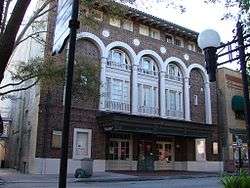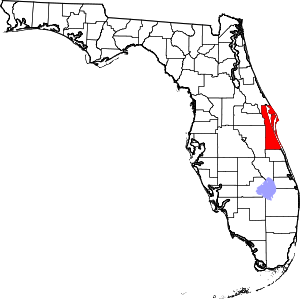Cocoa, Florida
Cocoa is a city in Brevard County, Florida. The population was 17,140 at the 2010 United States Census.[2] It is part of the Palm Bay–Melbourne–Titusville Metropolitan Statistical Area.
Cocoa, Florida | |
|---|---|
| City of Cocoa | |
  Top: Cocoa welcome sign; Bottom: Cocoa City Hall | |
 Location in Brevard County and the state of Florida | |
| Coordinates: 28°22′10″N 80°44′38″W | |
| Country | |
| State | |
| County | |
| Government | |
| • Type | Council-Manager |
| • Mayor | Jake Williams, Jr. |
| • City Manager | John Titkanich, Jr. |
| Area | |
| • Total | 15.41 sq mi (39.91 km2) |
| • Land | 13.34 sq mi (34.55 km2) |
| • Water | 2.07 sq mi (5.36 km2) |
| Elevation | 36 ft (11 m) |
| Population | |
| • Total | 17,140 |
| • Estimate (2019)[3] | 18,603 |
| • Density | 1,394.63/sq mi (538.45/km2) |
| Time zone | UTC−5 (Eastern (EST)) |
| • Summer (DST) | UTC−4 (EDT) |
| Area code(s) | 321 |
| FIPS code | 12-13150[4] |
| GNIS feature ID | 0280608[5] |
| Website | www.CocoaFL.org |
History
Several stories circulate among Cocoa old timers as to how the town got its name. One story says that the mail used to come by river boat and was placed in an empty tin box labeled Baker's Cocoa. The box was nailed to a piling in the river next to downtown. Additionally, an early hotel in the area, located on the Indian River lagoon, was named Cocoa House.[6]
In 1885, the S. F. Travis Hardware store opened; it is still in business as of 2014.[7] Cocoa's business district was mostly destroyed by fire in 1890. But soon, significant development was stimulated by the extension of the Jacksonville, St. Augustine, and Indian River Railway to Cocoa.
The city was chartered on October 1, 1895.[8][9] In the winter of 1894–1895, Cocoa had an economic setback when the "Great Freeze" destroyed the citrus crop and forced many citrus workers to seek new jobs. According to one source, by 1903, the population of Cocoa had dropped to 382.
During the second decade of the 20th century, population growth and economic development in Cocoa accelerated. The state business directory of 1911–1912 set the population at 550. By 1925, the population was estimated at 1,800. During the Great Depression, the local economy declined and the two local banks failed. Still, by 1930, the population had risen to 2,200.
The population rose dramatically following the development of the space industry, quadrupling from 3,098 in 1940 to 12,244 in 1960. Cocoa and the surrounding area also became integrated with the tourist industry for the first time, as thousands visited the area to witness the launches from Cape Canaveral. By 1980, the population had grown to 16,096.[10]
Education was segregated until the 1960s, at which time Monroe High School and elementary schools for black students were closed.[11]
In 1964, the Cocoa Expo Sports Center (Cocoa Stadium) was built for the Colt 45s spring baseball training and Grapefruit League games. The team later became the Houston Astros.[12] In the early 1980s, the city attempted to upgrade the stadium by asking the Astros to pay for needed repairs. In 1985, the team responded by moving its training to Osceola County Stadium in Kissimmee. As a result, it was decided that future negotiations with major league teams would be done by the county government.
Clearlake Middle School was closed in 2013. Students were moved to Cocoa High School, which was converted to a junior and senior high school.[13]
In 2018, Cocoa was listed as the 11th most dangerous city in America by the National Council for Home Safety and Security.[14]
Geography

Cocoa is located at 28°22′10″N 80°44′38″W.[15]
According to the United States Census Bureau, the city has a total area of 15.4 square miles (39.9 km2). 13.3 square miles (34.5 km2) of it is land and 2.1 square miles (5.4 km2) of it (13.46%) is water.[16] Cocoa is home to the highest point in Brevard County, listed by the USGS as being 83 feet (25 m) above sea level at its apex.[17]
Fauna
The Cocoa Bird Count has annually counted species of birds in or near Cocoa since 1950. In 2010, it counted 150 species. There was an annual "Christmas Bird Count" before this, starting in 1900.[18]
Government
Cocoa first approved the Council-Manager form of government in 1959, and subsequent changes to the state statutes mirrored the City of Cocoa's Council-Manager Plan. The City Council serves as the Board of Directors for the City, with the Mayor as Chairman. The City Manager serves as the Chief Executive. The City Council for the City of Cocoa is made up of five members; the Mayor is elected at large and the four council members are elected by each of their districts.[8]
- Mayor - Jake Williams Jr.
- Councilman, District 1 - Michael Blake
- Councilwoman, District 2 - Brenda Warner
- Councilman, District 3 - Don Boisvert
- Councilman, District 4 - Tyler Furbish
- City Manager (appointed) - John Titkanich Jr.[19]
In 2007, the city had a taxable real estate base of $1.18 billion.[20]
Cocoa has its own fire department with three stations. There is a county fire department within the city limits.[21]
In 2015 there were 69 police officers and 44 firemen.
Demographics
| Historical population | |||
|---|---|---|---|
| Census | Pop. | %± | |
| 1890 | 312 | — | |
| 1900 | 382 | 22.4% | |
| 1910 | 613 | 60.5% | |
| 1920 | 1,445 | 135.7% | |
| 1930 | 2,164 | 49.8% | |
| 1940 | 3,098 | 43.2% | |
| 1950 | 4,245 | 37.0% | |
| 1960 | 12,294 | 189.6% | |
| 1970 | 16,110 | 31.0% | |
| 1980 | 16,096 | −0.1% | |
| 1990 | 17,722 | 10.1% | |
| 2000 | 16,412 | −7.4% | |
| 2010 | 17,140 | 4.4% | |
| Est. 2019 | 18,603 | [3] | 8.5% |
| U.S. Decennial Census[22] | |||
As of the census[4] of 2000, there were 16,412 people, 6,939 households, and 4,232 families residing in the city. The population density was 2,200.3 inhabitants per square mile (849.4/km2). There were 8,064 housing units at an average density of 1,081.1 per square mile (417.4/km2). The racial makeup of the city was 62.47% White, 32.28% African American, 0.63% Native American, 0.94% Asian, 0.23% Pacific Islander, 1.58% from other races, and 1.87% from two or more races. Hispanic or Latino of any race were 4.93% of the population.
There were 6,939 households, out of which 28.4% had children under the age of 18 living with them, 37.0% were married couples living together, 19.2% had a female householder with no husband present, and 39.0% were non-families. 32.0% of all households were made up of individuals and 11.5% had someone living alone who was 65 years of age or older. The average household size was 2.35 and the average family size was 2.97.
In the city, the population was distributed as follows: 26.4% under the age of 18, 8.6% from 18 to 24, 29.1% from 25 to 44, 21.6% from 45 to 64, and 14.3% who were 65 years of age or older. The median age was 36 years. For every 100 females, there were 90.5 males. For every 100 females age 18 and over, there were 86.4 males.
Economy

in Cocoa Riverfront Park
Personal income
According to the 2013 American Community Survey:
- Median household income = $32,162
- Median family income = $40,252
- Median income for males = $45,274
- Median income for females = $28,779
- Per capita income = $20,350
- Below the poverty line:
- Population = 27.1%
Industry
Construction and retail trade are the two largest industries by employment in Cocoa as of 2017.[8] In 2008, Kel-Tec CNC Industries, located in Cocoa, was the third-largest manufacturer of pistols in the United States.[23][24] Cocoa has 1,381 registered businesses that include light manufacturing and industrial, retail and office businesses as of 2017.[8] Cocoa hosts one of the facilities building SpaceX Starship.[25]
Workforce
In 2017, 9,633 persons were employed, with 84% having a high school education or higher.[8]
Cocoa Village

The historic downtown area is called Cocoa Village along Florida Avenue and Stone Street. It has shops and restaurants, and is surrounded by historic buildings and the Cocoa Riverfront Park. The Florida Historical Society is headquartered in the historic Cocoa Post Office, originally built in 1939 by the Works Progress Administration. The area was revitalized by funding for public infrastructure through the Cocoa Redevelopment Agency, City and private investment.
Tourism
Tourism is high in the downtown historic business district. Cruise passenger tourists come from Port Canaveral on excursions or day trips.[26] In addition, tourists are attracted to the historic sites and local attractions such as the Brevard Museum of History & Natural Science, the Eastern Florida State College Planetarium and Observatory, Historic Cocoa Village, Indian River Queen (excursion boat), Indian River Drive scenic by-pass, the Aladdin Theater, Historic Porcher House, and Riverfront Park. Historic Cocoa Village has shopping and two Golden Spoon award-winning restaurants, and boutiques. The city sponsors more than 50 special events each year.[8]
Education
The city area has the following educational institutions:
Higher education:
- Eastern Florida State College - Cocoa Campus[27]
- University of Central Florida, Cocoa Campus[28]
Public school system:
- Cocoa High School[29]
- Cambridge Elementary School[30]
- Saturn Elementary School[31]
- Endeavor Elementary Magnet School[32]
Private schools:
Infrastructure
Transportation
Major roads
All are at least four-lane roads, unless otherwise designated.[8]





Rail
The Florida East Coast Railway runs through Cocoa. A planned Virgin Trains USA higher speed rail expansion is designed to connect Orlando to Miami making a turn in Cocoa (designated the "Cocoa Curve").
Bus
Space Coast Area Transit operates a public bus service in Cocoa and vicinity.[36][37]
Water

Since 1957, Cocoa has supplied the communities of central Brevard County with potable water. Cocoa made major investments in the water supply and treatment facilities needed to produce a sub-regional water system.
In 2017, Cocoa provided an average of 23,000,000 US gallons (87,000,000 l; 19,000,000 imp gal) of water daily to over 80,000 customers (250,000 people)[38][8] in Cocoa, Rockledge, Port St. John, Merritt Island, Cape Canaveral, Cocoa Beach, Suntree/Viera, Patrick Air Force Base, Kennedy Space Center and Port Canaveral.
Cocoa's water system includes the wellfield and raw water collection system, Wewahootee Water Treatment Plant, transmission mains, and the Dyal Water Treatment Plant (WTP). Cocoa's drinking water sources include the Floridian Aquifer, Intermediate Aquifer, Taylor Creek Reservoir, and Aquifer Storage and Recovery (ASR) wells. All of these facilities are located in east Orange County. A distribution system and storage pumping facilities are located in Brevard County.
The Dyal WTP processes about nine billion gallons per year, with peak flows reaching 38 million gallons per day (mgd) during the summer. Daily flows average 25 mgd. The Dyal WTP is unusual for Central Florida because it is capable of treating both ground and surface water.
The flag was originally painted on the water tower free of charge by a Greek immigrant. He wanted to decorate the tower in time for the United States Bicentennial celebration in 1976.[39] In 2014, the City re-furbished and re-painted the tower with the iconic American flags.
Media
Television station
- WUCF-TV 68, a PBS member station operated by a consortium of the University of Central Florida and Eastern Florida State College.
Points of interest
- Florida Solar Energy Center
- Brevard Museum of History & Natural Science
- Alma Clyde Field Library of Florida History[40]
Historic sites

Athletics
The Houston Astros held spring training in Cocoa from 1964 through 1984, and the Florida Marlins trained in Cocoa in 1993. Cocoa Stadium was also the long-time home of the Florida State League Cocoa Astros.
In 2009, the Space Coast Surge, a member of the Florida Winter Baseball League, had Cocoa Stadium as its home stadium.[41] The league suspended operations in November 2009.[42]
Cocoa High School has numerous state champion athletic teams. In 2015, the Cocoa High School football team was ranked 13th in the State of Florida and 1st in the county and had a 35-game winning streak against other Brevard County schools.
Notable people
- Jumaine Jones, professional basketball player [43]
- Tarean Folston, football player at the University of Notre Dame [44]
- Emory L. Bennett, United States Army soldier during the Korean War and Medal of Honor recipient.[45] A statue of him is in Cocoa Riverfront Park.
- Chip Skowron, hedge fund portfolio manager convicted of insider trading
Sister city

References
- "2019 U.S. Gazetteer Files". United States Census Bureau. Retrieved July 2, 2020.
- "Profile of General Population and Housing Characteristics: 2010 Demographic Profile Data (DP-1): Cocoa city, Florida". United States Census Bureau. Retrieved January 27, 2012.
- "Population and Housing Unit Estimates". United States Census Bureau. May 24, 2020. Retrieved May 27, 2020.
- "U.S. Census website". United States Census Bureau. Retrieved 2008-01-31.
- "US Board on Geographic Names". United States Geological Survey. 2007-10-25. Retrieved 2008-01-31.
- Mike Miller (2016). "Cocoa Florida from the Civil War to the Space Age". Florida Backroads Travel. Retrieved 2016-02-01.
- "History". The S.F. Travis Company. 2014-02-26.
- "2017 Annual Economic Development Update". Cocoa Economic Development. 2018. Archived from the original on August 13, 2019. Retrieved August 13, 2019.
- "History". cocoafl.org. 2010-01-17. Archived from the original on November 2, 2010.
- History Archived 2010-10-21 at the Wayback Machine Cocoa, Fla. Official Website. Accessed on 2009-06-24.
- Basu, Rebecca (14 March 2010). "Cocoa's class of 1950 shares life stories at reunion". Melbourne, Florida: Florida Today. pp. 1D. Archived from the original on 3 July 2014.
- "Houston Astros Spring Training". Spring Training Online. Retrieved 3 February 2015.
- "School Board Votes To Shutter Three Schools". Retrieved 3 February 2015.
- https://www.alarms.org/top-100-most-dangerous-cities-in-america-2018/
- "US Gazetteer files: 2010, 2000, and 1990". United States Census Bureau. 2011-02-12. Retrieved 2011-04-23.
- "Geographic Identifiers: 2010 Demographic Profile Data (G001): Cocoa city, Florida". United States Census Bureau. Retrieved January 27, 2012.
- USGS, USGS (April 19, 2007). "High Point Height". USGS. Archived from the original on October 24, 2004. Retrieved 2007-04-19.
- Winston, Keith (25 December 2010). "Brevard Naturally:Citizen scientists collect vital information". Melbourne, Florida: Florida Today. pp. 4D.
- Berman, David (November 27, 2011). "Cocoa pays manager $115,000". Florida Today. Melbourne, Florida. pp. 1B.
- Dean, James (April 26, 2008). More taxes or fewer services. Florida Today.
- "The Fact Book". Florida Today. Melbourne, Florida. March 26, 2011. p. 29.
- "Census of Population and Housing". Census.gov. Retrieved June 4, 2015.
- according to the Bureau of Alcohol, Tobacco, Firearms and Explosives (ATF)
- retrieved August 24, 2008 Archived May 12, 2015, at the Wayback Machine
- Amy Thompson (June 24, 2019). "SpaceX's 'Starship' Prototype Coming Together in Florida". Space.com. Retrieved August 13, 2019.
- "Day Cruises in Cape Canaveral, FL". Retrieved July 23, 2020.
- Eastern Florida State College
- Cocoa Campus
- Cocoa High School
- "Cambridge Elementary School". Edline. Retrieved 2017-09-14.
- "Saturn Elementary School". Edline. Retrieved 2017-09-14.
- "Endeavour Elementary Magnet". Edline. Retrieved 2017-09-14.
- "Emma Jewel Charter Academy". Edline. Retrieved 2017-09-14.
- "stmarksacademy". stmarksacademy. Retrieved 2017-09-14.
- Rick Neale (2010-09-15). "'State of the System' identifies Brevard County's busiest roads". Florida Today. Florida Today. Missing or empty
|url=(help) - Space Coast Area Transit official website Archived 2011-07-15 at the Wayback Machine
- "Interactive System Map". Retrieved 3 February 2015.
- Waymer, Jim (October 22, 2017). "How the system came undone". Florida Today. Melbourne, Florida. pp. 8A. Retrieved October 27, 2017.
- David Salisbury (1986-05-18). "What's The Answer?". Orlando Sentinel. Retrieved 2015-10-16.
- "Libraries and Collections | Florida Journalism History Project". Uflib.ufl.edu. 2009-11-23. Retrieved 2011-12-06.
- "車査定". Archived from the original on 3 February 2015. Retrieved 3 February 2015.
- "Leesburg Daily Commercial article, November 19, 2009". Archived from the original on 2009-11-22. Retrieved 2009-11-22.
- "Jumaine Lanard Jones". Basketball-Reference.com. Retrieved December 21, 2012.
- "Tarean Folston". UND.com. Archived from the original on August 1, 2016. Retrieved July 29, 2016.
- "Emory Bennett - Recipient - Military Times Hall Of Valor". militarytimes.com. Retrieved March 26, 2019.
- Schaefer, Gayla. "Communities create ties: Cocoa, Israeli town become sister cities with ceremony", Florida Today, September 28, 2007. Accessed October 7, 2007. "As of Sunday, Oct. 7, the city of Cocoa and the city of Beit Shemesh, Israel will become sisters."
External links
| Wikimedia Commons has media related to Cocoa, Florida. |
